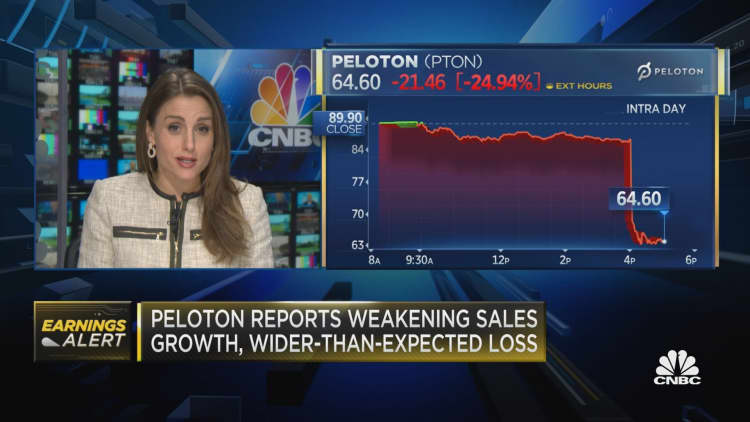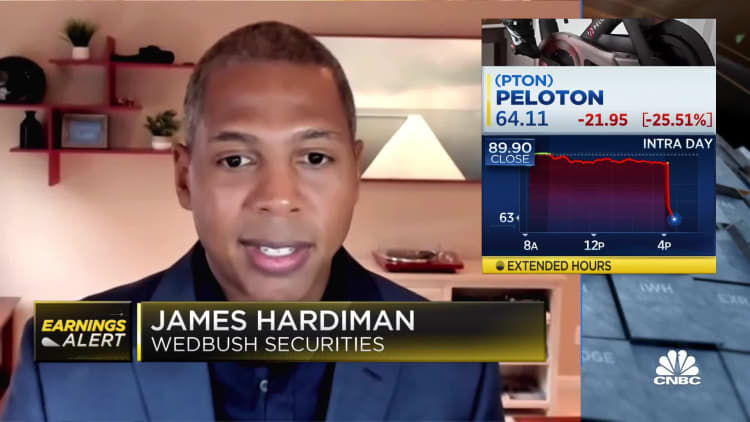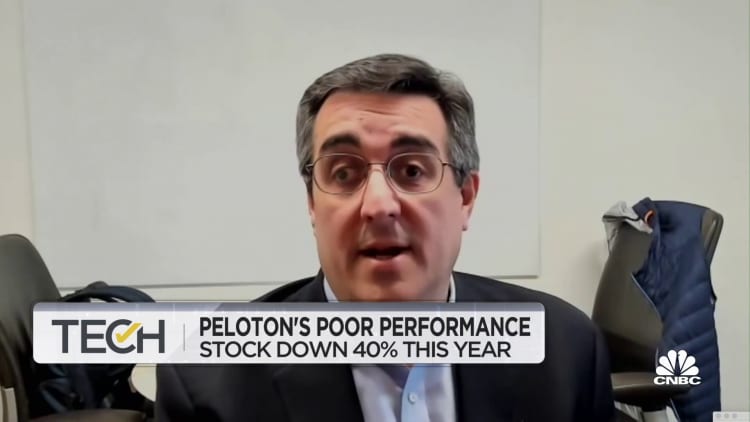Peloton shares tumbled more than 25% on Thursday, after the company reported weakening sales growth and a wider-than-expected loss in its fiscal first quarter.
The company slashed its outlook for the full fiscal year amid softened demand for its exercise equipment and ongoing supply chain challenges. More consumers are opting to return to gyms such as Planet Fitness and Equinox, or fitness junkies are purchasing another at-home option from the flurry of companies that sell everything from rowing machines to connected mirrors.

"We anticipated fiscal 2022 would be a very challenging year to forecast, given unusual year-ago comparisons, demand uncertainty amidst re-opening economies, and widely-reported supply chain constraints and commodity cost pressures," Chief Executive Officer John Foley said in a letter to shareholders.
A slower-than-expected start to the second quarter and "challenged visibility" in the near term led the company to lower its expectations, Foley said.
Here's how Peloton did in its fiscal first quarter compared with what analysts polled by Refinitiv were expecting:
- Loss per share: $1.25 vs. $1.07 expected
- Revenue: $805.2 million vs. $810.7 million expected
For the three-month period ended Sept. 30, Peloton reported a net loss of $376 million, or $1.25 per share, compared with net income of $69.3 million, or earnings of 20 cents a share, a year earlier. Analysts had been looking for Peloton to post a loss of $1.07 per share.
Revenue grew 6% to $805.2 million from $757.9 million a year earlier, missing estimates for $810.7 million.

That marked a significant slowdown from the 250% sales surge that Peloton booked in the first quarter of 2020, when consumers were eager to get their hands on at-home bikes to workout when gyms were closed.
Sales of connected fitness products, including its Bikes and Treads, fell 17% to $501 million. Subscription revenue grew 94% to $304.1 million. Connected fitness sales accounted for 62% of Peloton's business in the quarter.
Peloton counted 2.49 million connected fitness subscribers at the end of the three-month period, up 87% year over year. Connected fitness subscribers are people who own a Peloton product and also pay a monthly fee to access the company's digital workout content.
Its entire member base, which includes digital-only subscribers, totaled 6.2 million.
Average net monthly connected fitness churn, which Peloton uses to measure retention of connected fitness subscribers, ticked up to 0.82% from 0.73% in the prior quarter.
Connected fitness subscribers completed 16.6 workouts per month, on average, a drop from 20.7 workouts a year earlier.
Price cut to Bike disappoints
Sales and marketing expenses surged 148% to $284.3 million, representing roughly 35% of revenue.
The company has poured dollars into advertising its now less-expensive Bike product and Tread treadmill machine. The latter was just recently put back on sale in the U.S. following a widespread recall.
In August, Peloton slashed the price of its original Bike by 20% to $1,495. On Thursday, Chief Financial Officer Jill Woodworth said that while Bike sales accelerated after the change, the results haven't entirely met Peloton's expectations.
"While the price drop led to conversion rates that exceeded our forecast, overall traffic has not met our initial expectation," Woodworth told analysts on an earnings call. "We've also seen a richer than anticipated mix of Bike sales versus Bike+, further impacting both revenue and our growth margin expectation."
Peloton's gross margins in the latest quarter fell to 12% from 39.4% a year earlier.
CEO Foley added that the company still has more work to do to educate consumers about the Tread product. However, he still believe treadmills will grow to one day be a bigger category for Peloton than bikes.
But Peloton faces heightened competition to continue growing equipment sales and keep people around. Companies such as Tonal, Hydrow and Mirror are winning customers in the at-home market. While shares of Planet Fitness hit a record high earlier Thursday after the gym chain offered up a better-than-anticipated outlook.
"At the end of the day, we are seeing how large the Peloton business is rather than how far its voice has spread," BMO Capital Markets analyst Simeon Siegel said. "What Peloton has accomplished is remarkable, but that doesn't mean its trajectory is limitless."
"Connected fitness is becoming a sector rather than a one company story," Siegel added.
Peloton cuts forecast
Due to the uncertain nature of the pandemic, Peloton said it is now presenting its outlook in ranges, rather than single estimates.
It sees its connected fitness subscriber count growing to between 2.8 million and 2.85 million in the second quarter. Sales are forecast between $1.1 billion and $1.2 billion. Analysts were looking for $1.5 billion.
Peloton added that it expects a "healthy" holiday season, now that it has adequate inventory to meet demand and normal delivery windows.
For the fiscal year, it slashed its expectations for subscribers and sales. It now anticipates connected fitness subscribers to amount to between 3.35 million to 3.45 million, down from a prior outlook of 3.63 million. It sees revenue ranging between $4.4 billion to $4.8 billion, down from $5.4 billion. Analysts' consensus was for $5.39 billion.
"The primary drivers of our reduced forecast are a more pronounced tapering of demand related to the ongoing opening of the economy, and a richer than anticipated mix of sales to our original Bike," the company said.
Peloton added that, in conjunction with its revised forecast, it will be looking at its expense base and adjusting operating costs to better align investments with the new growth expectations.
Opportunities for cost savings include scaling back hiring plans and limiting the number of bricks-and-mortar retail locations it opens, according to Woodworth.
The company forecasts being profitable, before interest, taxes, depreciation and amortization, by fiscal 2023.
Peloton shares have fallen 43% year to date, as of market close Thursday. The company's market cap is about $26 billion.
Find the full earnings release from Peloton here.



